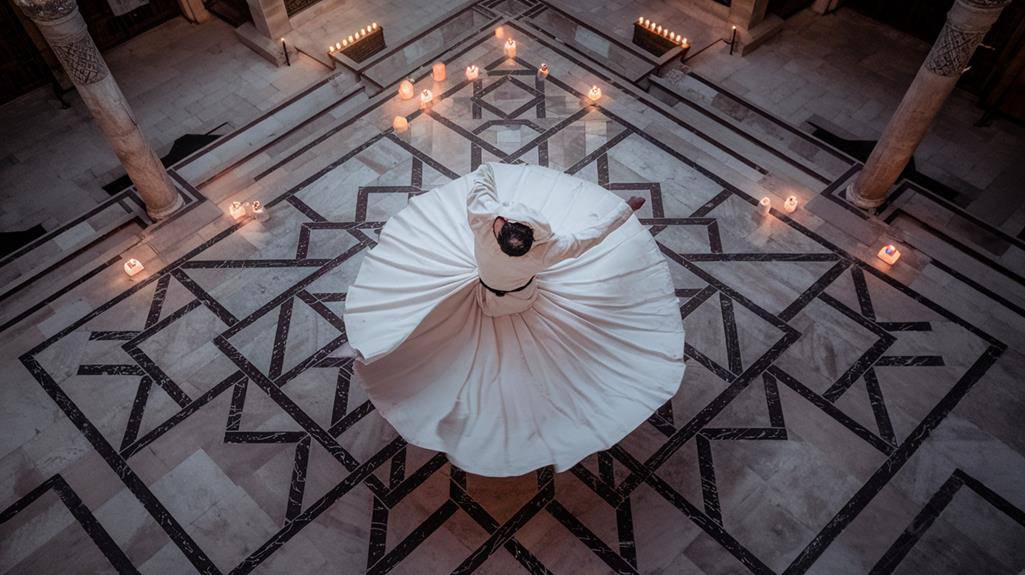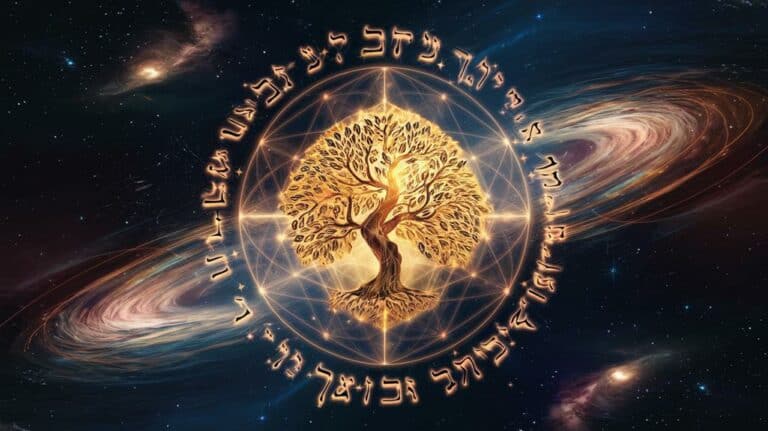What Is Mysticism in Islam?
You’ll find that mysticism in Islam goes far beyond the conventional practices of daily prayers and rituals. At its heart lies a transformative spiritual journey that’s captivated seekers for over fourteen centuries. Through Sufism, its most prominent mystical tradition, practitioners endeavor to experience a direct, personal connection with the Divine—moving past the outer shell of religion to touch its luminous core. While millions faithfully follow Islamic law, mystics have always yearned for something deeper: the intimate knowledge of God that transcends mere doctrine. What they’ve discovered on this path has profoundly shaped Islamic spirituality and continues to intrigue both Muslims and non-Muslims alike.
Origins of Islamic Mysticism
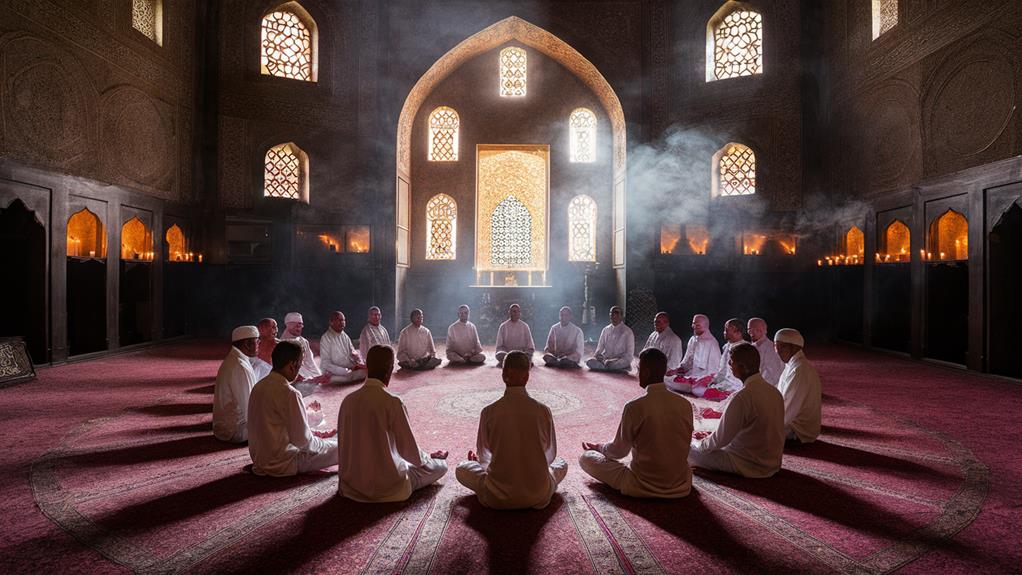
Islamic mysticism, known as Tasawwuf or Sufism, emerged during the first century after Muhammad’s death as Muslims sought deeper spiritual connections beyond ritual worship.
You’ll find that early mystics drew inspiration from Quranic verses emphasizing God’s nearness and the importance of remembrance (dhikr), while they’ve incorporated ascetic practices similar to Christian desert fathers.
As you explore Sufism’s roots, you’ll discover how political turmoil and social changes in the expanding Islamic empire led many seekers to turn inward. They weren’t satisfied with merely following religious laws; they yearned to taste the essence of divine truth.
You’ll notice how early mystics like Hasan al-Basri and Rabia al-Adawiyya developed concepts of divine love and spiritual poverty that would define Islamic mysticism for centuries to come.
Through these foundational years, you’ll see how Sufism began weaving together Quranic wisdom, prophetic traditions, and direct spiritual experiences.
It’s fascinating to observe how these mystics developed systematic methods for spiritual purification while maintaining their commitment to Islamic law, creating a path that’s both deeply personal and firmly rooted in traditional Islamic teachings.
Core Principles of Sufism
Sufism’s core principles rest on three fundamental concepts: fana (annihilation of the ego), baqa (subsistence in divine unity), and dhikr (remembrance of God).
Through fana, you’ll learn to dissolve your ego-self, letting go of worldly attachments that keep you bound to illusion. This dissolution isn’t about losing yourself but discovering your true nature beyond the confines of personality.
In baqa, you’ll experience a profound state of remaining in divine consciousness, where you’re fully present with the Ultimate Reality. It’s the stage where you’ve transcended the limitations of individual existence while paradoxically becoming more authentically yourself. This transformation isn’t achieved through intellectual understanding alone but through direct experience.
Dhikr serves as your constant companion on this journey, a practice of remembering God through various forms: silent meditation, rhythmic breathing, or the repetition of divine names.
You’ll find that this remembrance isn’t just a mental exercise but a total engagement of your being. As you deepen your practice, you’ll discover that these principles aren’t separate paths but interconnected aspects of the same transformative journey toward divine unity.
The Sufi Path
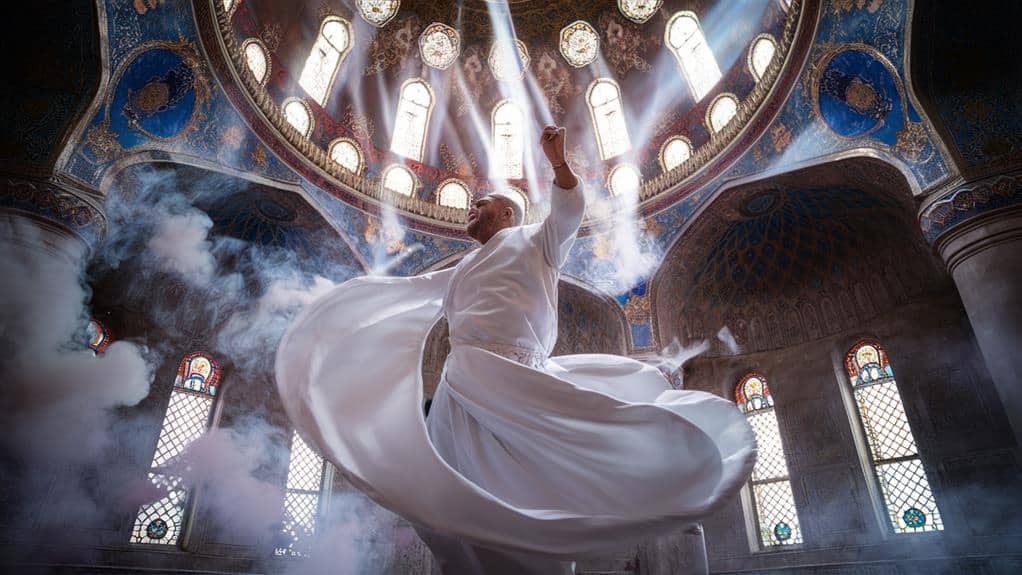
The path toward spiritual enlightenment in Sufism follows a structured journey that builds upon the core principles of fana, baqa, and dhikr.
You’ll find yourself traversing distinct stages, known as maqamat, each requiring mastery before progression. Through these stations, you’ll cultivate virtues like repentance, patience, and gratitude, gradually shedding your ego’s constraints.
As you advance on this mystical journey, you’ll experience temporary spiritual states called ahwal – divine gifts that wash over you like waves, offering glimpses of ultimate reality.
You’re not walking this path alone; a spiritual guide, or murshid, helps navigate these profound waters, ensuring you don’t lose your way in the depths of spiritual experience. The relationship between you and your murshid mirrors the ancient tradition of heart-to-heart transmission that’s kept Sufism alive for centuries.
Your progression isn’t linear – it’s a spiral path where you’ll revisit familiar territories with deeper understanding.
Each turn brings you closer to the divine presence, transforming your consciousness until you’re no longer separate from what you seek – you’ve become what you’ve always been.
Notable Mystics Through History
Throughout history’s unfolding tapestry, Muslim mystics have illuminated the spiritual path with their profound teachings and transformative works.
You’ll find Rabi’a al-Adawiyya, the 8th-century female mystic who pioneered the concept of Divine Love, teaching that you should love God for God’s sake alone, not out of fear or desire for reward.
In her footsteps, you’ll discover Al-Ghazali, whose “Revival of Religious Sciences” bridges the gap between orthodox Islam and mystical experience.
When you explore further, you’ll encounter Ibn Arabi, the 12th-century Andalusian sage known as “The Greatest Master,” who’ll challenge your understanding with his doctrine of the Unity of Existence.
You can’t overlook Rumi, whose poetry still resonates across centuries, inviting you to “come, come, whoever you are.” Through his verses, you’ll find universal themes of love, longing, and spiritual transformation that transcend cultural boundaries.
Each of these mystics offers you a unique gateway to understanding the Divine.
Their teachings aren’t just historical artifacts – they’re living traditions that continue to guide seekers on their spiritual journey, offering timeless wisdom for your own path to enlightenment.
Spiritual Practices and Rituals
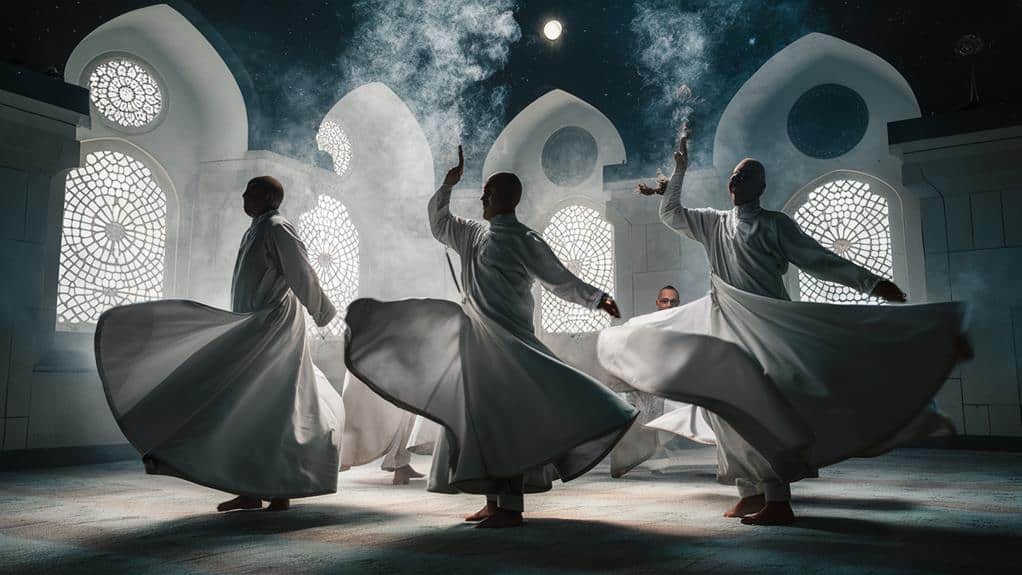
In mystical Islam, you’ll find spiritual practices that transform everyday rituals into profound acts of divine connection. Through dhikr, you’ll repeatedly chant sacred phrases or divine names, allowing your consciousness to merge with the rhythmic remembrance of Allah. As you engage in these meditative practices, you’re drawing closer to the divine presence that mystics seek to experience directly.
You’ll discover that Sufi practices often incorporate breath control, where each inhale and exhale becomes a sacred bridge between the material and spiritual domains. During sama, or spiritual concerts, you might experience the transcendent power of mystical music and poetry, while whirling ceremonies guide you toward states of ecstatic union with the divine.
These practices aren’t separate from traditional Islamic worship; rather, they’re deepened expressions of conventional religious obligations.
Through spiritual retreats known as khalwa, you’ll enter periods of isolation and contemplation, stripping away worldly attachments to reveal your essential nature. The path requires dedication to a spiritual guide, or murshid, who’ll help you navigate the subtle domains of mystical experience while maintaining alignment with Islamic principles.
Divine Love in Mysticism
Divine love stands at the heart of Islamic mysticism, where Sufis view their spiritual journey as an ever-deepening relationship with Allah. You’ll discover that this divine love, or ishq-e-haqiqi, transcends ordinary human affection, drawing you into a domain where your soul yearns for union with the Divine.
Through this mystical path, you’ll find yourself shedding worldly attachments as you’re transformed by an all-consuming love that burns away the veils between you and the Divine Beloved.
In your pursuit of divine love, you’ll encounter the concept of fana (annihilation of the self) and baqa (subsistence in God), where you’re called to dissolve your ego until nothing remains but pure devotion. This love isn’t passive; it’s a dynamic force that’ll reshape your entire being.
You’ll recognize it in the ecstatic poetry of Rumi, the passionate writings of Rabia al-Basri, and the teachings of countless Sufi masters who’ve walked this path before you. Through practices like dhikr (remembrance) and sama (spiritual concerts), you’ll open yourself to experiencing this transformative love that mystics say can’t be described, only felt within the heart’s deepest chambers.
Poetry and Mystical Expression

Poetic expression serves as the primary vessel through which Sufi mystics communicate their experiences of divine love. You’ll find that when words fail to capture the ineffable nature of mystical experiences, poetry steps in with its unique ability to transcend ordinary language.
Through metaphor and symbolism, you’re invited to explore the depths of spiritual consciousness that prose alone can’t reach.
As you explore Sufi poetry, you’ll discover how masters like Rumi and Hafez weave intricate tapestries of meaning, where the earthly and divine intertwine. They’ll show you how the lover’s yearning for the beloved mirrors your soul’s longing for divine union.
You’ll encounter recurring symbols – the tavern, the wine, the moth and flame – each carrying layers of spiritual significance that you can unpack through contemplation.
The mystical poets don’t just write about divine love; they create a gateway through which you can experience it yourself. In their verses, you’ll find that the boundaries between sacred and secular dissolve, revealing how every aspect of existence can become a mirror reflecting divine beauty.
Sacred Knowledge and Enlightenment
Sacred knowledge within Islamic mysticism rests upon three fundamental pillars: direct spiritual experience, transmitted wisdom from masters, and divine revelation. You’ll find that these elements interweave to create a tapestry of understanding that transcends ordinary consciousness.
As you explore deeper into mystical practices, you’re guided to recognize that true knowledge isn’t merely intellectual but emerges from the heart’s awakening.
Through contemplative practices, you’ll discover that enlightenment isn’t a destination but an unfolding process of self-dissolution. You’re invited to traverse the stations of spiritual development, where each level of consciousness opens new dimensions of understanding.
The mystic’s path reveals that what you’ve considered knowledge before was merely information – true sacred knowledge transforms your very being. As you progress, you’ll understand why Sufi masters emphasize that real enlightenment comes through polishing the mirror of the heart until it reflects divine reality.
This journey isn’t about accumulating facts; it’s about removing the veils that separate you from direct perception of truth. Your understanding deepens as you realize that sacred knowledge ultimately leads to the extinction of the limited self in the ocean of divine consciousness.
Modern Sufi Movements
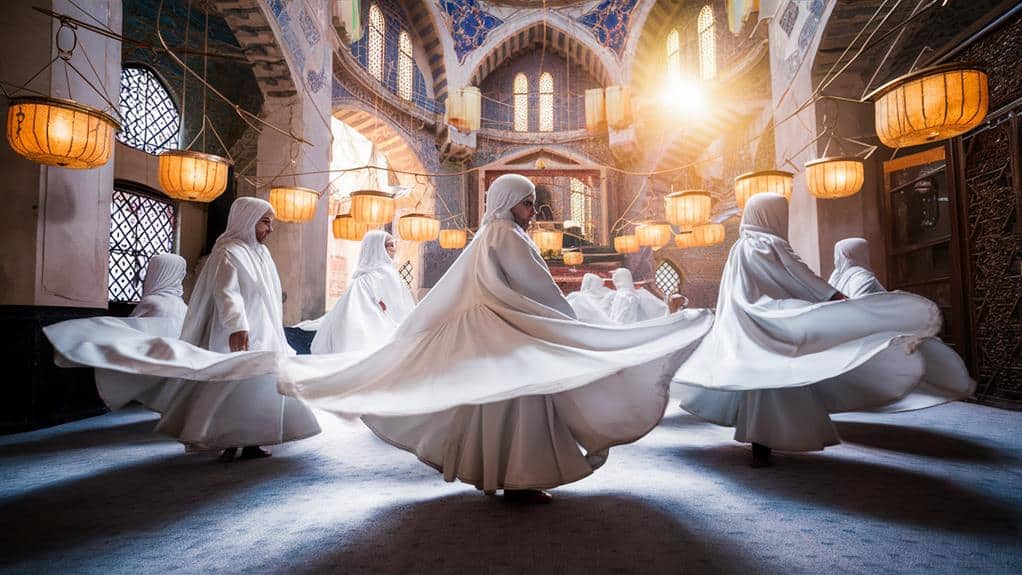
Emerging from traditional roots, contemporary Sufi movements have adapted to meet the spiritual needs of modern seekers while maintaining their mystical essence.
You’ll find these evolving traditions in unexpected places – from meditation centers in London to zhikr circles in New York City, where ancient practices merge with contemporary understanding.
In today’s interconnected world, you’re witnessing Sufi orders that bridge cultural divides, offering universal teachings that transcend religious boundaries.
They’ve embraced technology and social media to share wisdom, while preserving the intimate master-disciple relationship that’s central to spiritual growth.
You’ll discover how these movements have reinterpreted classical texts and practices for modern sensibilities, making mystical concepts accessible without diluting their transformative power.
As you explore these contemporary expressions of Sufism, you’ll encounter organizations focused on peace-building, environmental stewardship, and social justice – causes that reflect the tradition’s emphasis on divine love and service.
Modern Sufi movements don’t just preserve ancient wisdom; they’re actively engaging with today’s challenges, showing how mystical insights can illuminate paths through our complex world.
Impact on Islamic Culture
Islamic culture bears the indelible mark of Sufism’s influence across art, literature, and daily religious life. You’ll find its mystical essence woven into the intricate patterns of mosque calligraphy, where each arabesque curve suggests the infinite nature of divine love.
In poetry, you’ll discover how Sufi metaphors of spiritual intoxication and divine yearning have shaped the works of masters like Rumi and Hafez, whose verses you’re still likely to hear quoted in both sacred and secular settings today.
You can trace Sufism’s impact in the development of Islamic music, where the hypnotic rhythms of dhikr ceremonies have influenced devotional songs and qawwali performances.
The tradition’s emphasis on inner transformation has deeply affected how you might approach Islamic spirituality, offering a path that balances external religious observance with internal contemplation.
Even in modern Islamic architecture, you’ll notice how Sufi concepts of sacred geometry and divine harmony continue to inspire contemporary designs.
The mystical tradition’s focus on direct spiritual experience has given you a framework for understanding Islam that transcends mere doctrinal adherence, enriching your religious experience with layers of meaning and personal connection.
Conclusion
As you’ve journeyed through the mystical dimensions of Islam, you’ll find that its essence transcends mere religious practice, offering a timeless path to divine consciousness. Through Sufism’s rich tapestry of meditation, poetry, and spiritual disciplines, you’re invited to discover profound truths that continue to resonate in today’s world. Whether you’re drawn to the ecstatic verses of Rumi or the contemplative practices of modern Sufi orders, Islamic mysticism illuminates the eternal quest for divine connection.



